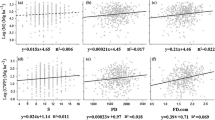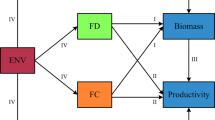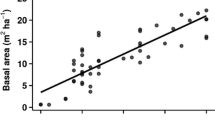Abstract
Functional traits and species richness have been used to assess variation in ecological functions in multiple ecosystems. However, biodiversity effects on ecosystem functioning could differ between ecosystem types and evaluating these associations could help assess ecosystem recovery in restoration sites. The objective of this study was to analyze the effect of species richness and plant functional traits on ecological processes related to nutrient cycling, productivity and regeneration in subtropical forest ecosystems. The study was performed in three sites (each site containing a reference forest and a forest undergoing restoration) located in the south of Brazil. We collected data on understory abundance, aboveground biomass, litter stock, decomposition, soil feeding activity, litter and soil quality and evaluated the association with tree species richness and plant traits (both community-weighted mean trait values—CWM, and functional diversity measures). Variables related to plant functional traits, especially CWM measures, were associated with most of the ecological processes analyzed. Leaf traits showed the strongest effect on the processes, especially for aboveground biomass, litter stock and understory abundance. Most relationships did not differ between reference and restoration sites. Our results support the mass-ratio theory, suggesting that dominant species traits are the ones that strongly affect ecosystem functioning, and suggest a secondary role of species number on the ecological processes analyzed. Our study provides evidence for the usefulness of functional traits to assess changes in ecological processes in forest ecosystems, with similar patterns in reference forests and forests undergoing restoration.

Similar content being viewed by others

References
Ali A, Yan ER. 2017. Functional identity of overstorey tree height and understorey conservative traits drive aboveground biomass in a subtropical forest. Ecol Indic 83:158–68.
Aronson J, Dhillion S, Le Floc’h E. 1995. On the need to select an ecosystem of reference, however imperfect: a reply to Pickett and Parker. Restor Ecol 3:1–3.
Balvanera P, Pfisterer AB, Buchmann N, He JS, Nakashizuka T, Raffaelli D, Schmid B. 2006. Quantifying the evidence for biodiversity effects on ecosystem functioning and services. Ecol Lett 9:1146–56.
Bardgett RD, Wardle DA. 2003. Herbivore-mediated linkages between aboveground and belowground communities. Ecology 84:2258–68.
Bertacchi MIF, Amazonas NT, Brancalion PHS, Brondani GE, De Oliveira ACS, De Pascoa MAR, Rodrigues RR. 2016. Establishment of tree seedlings in the understory of restoration plantations: natural regeneration and enrichment plantings. Restor Ecol 24:100–8.
Botta-Dukát Z. 2005. Rao’s quadratic entropy as a measure of functional diversity based on multiple traits. J Veg Sci 16:533–40.
Boukili VK, Chazdon RL. 2017. Environmental filtering, local site factors and landscape context drive changes in functional trait composition during tropical forest succession. Perspect Plant Ecol Evol Syst 24:37–47.
Buchmann T, Schumacher J, Ebeling A, Eisenhauer N, Fischer M, Gleixner G, Hacker N, Lange M, Oelmann Y, Schulze E-D, Weigelt A, Weisser WW, Wilcke W, Roscher C. 2018. Connecting experimental biodiversity research to real-world grasslands. Perspect Plant Ecol Evol Syst 33:78–88.
Burger D, Delitti W. 2008. Allometric models for estimating the phytomass of a secondary Atlantic Forest area of southeastern Brazil. Biota Neotrop 8:2–7.
Cardinale BJ, Srivastava DS, Duffy JE, Wright JP, Downing AL, Sankaran M, Jouseau C. 2006. Effects of biodiversity on the functioning of trophic groups and ecosystems. Nature 443:989–92.
Cardinale BJ, Wright JP, Cadotte MW, Carroll IT, Hector A, Srivastava DS, Loreau M, Weis JJ. 2007. Impacts of plant diversity on biomass production increase through time because of species complementarity. Proc Natl Acad Sci 104:18123–8.
Chave J, Coomes D, Jansen S, Lewis SL, Swenson NG, Zanne AE. 2009. Towards a worldwide wood economics spectrum. Ecol Lett 12:351–66.
Dahlgren JP, Eriksson O, Bolmgren K, Strindell M, Ehrlén J. 2006. Specific leaf area as a superior predictor of changes in field layer abundance during forest succession. J Veg Sci 17.
de Bello F, Lavorel S, Díaz S, Harrington R, Cornelissen JHC, Bardgett RD, Berg MP, Cipriotti P, Feld CK, Hering D, da Silva PM, Potts SG, Sandin L, Sousa JP, Storkey J, Wardle DA, Harrison PA. 2010. Towards an assessment of multiple ecosystem processes and services via functional traits. Biodivers Conserv 19:2873–93.
Dent DH, Dewalt SJ, Denslow JS. 2013. Secondary forests of central Panama increase in similarity to old-growth forest over time in shade tolerance but not species composition. J Veg Sci 24:530–42.
Dias ATC, Cornelissen JHC, Berg MP. 2017. Litter for life: assessing the multifunctional legacy of plant traits. J Ecol 105:1163–8.
Díaz S, Cabido M. 2001. Vive la difference: plant functional diversity matters to ecosystem processes: plant functional diversity matters to ecosystem processes. Trends Ecol Evol 16:646–55.
Díaz S, Fargione J, Chapin FS, Tilman D. 2006. Biodiversity loss threatens human well-being. PLoS Biol 4:1300–5.
Díaz S, Kattge J, Cornelissen JHC, Wright IJ, Lavorel S, Dray S, Reu B, Kleyer M, Wirth C, Prentice IC, Garnier E, Bönisch G, Westoby M, Poorter H, Reich PB, Moles AT, Dickie J, Gillison AN, Zanne AE, Chave J, Wright SJ, Sheremet’ev SN, Jactel H, Christopher B, Cerabolini B, Pierce S, Shipley B, Kirkup D, Casanoves F, Joswig JS, Günther A, Falczuk V, Rüger N, Mahecha MD, Gorné LD. 2016. The global spectrum of plant form and function. Nature 529:167–71.
Díaz S, Lavorel S, de Bello F, Quetier F, Grigulis K, Robson TM. 2007. Incorporating plant functional diversity effects in ecosystem service assessments. Proc Natl Acad Sci 104:20684–9.
Erickson H, Keller M, Davidson EA. 2001. Nitrogen Oxide Fluxes and Nitrogen Cycling during Postagricultural Succession and Forest Fertilization in the Humid Tropics. Ecosystems 4:67–84.
Eviner VT, Hawkes CV. 2008. Embracing variability in the application of plant–soil interactions to the restoration of communities and ecosystems. Restor Ecol 16:713–29.
FAO (Food and Agriculture Organization of the United Nations). 2012. Global ecological zones for FAO forest reporting: 2010 Update. Rome.
Finegan B, Peña-Claros M, de Oliveira A, Ascarrunz N, Bret-Harte MS, Carreño-Rocabado G, Casanoves F, Díaz S, Eguiguren Velepucha P, Fernandez F, Licona JC, Lorenzo L, Salgado Negret B, Vaz M, Poorter L. 2015. Does functional trait diversity predict above-ground biomass and productivity of tropical forests? Testing three alternative hypotheses. J Ecol 103:191–201.
Finerty GE, de Bello F, Bílá K, Berg MP, Dias ATC, Pezzatti GB, Moretti M, Aerts R. 2016. Exotic or not, leaf trait dissimilarity modulates the effect of dominant species on mixed litter decomposition. J Ecol 104:1400–9.
Fujii S, Mori AS, Koide D, Makoto K, Matsuoka S, Osono T, Isbell F. 2017. Disentangling relationships between plant diversity and decomposition processes under forest restoration. J Appl Ecol 54:80–90.
García-Palacios P, Maestre FT, Milla R. 2013. Community-aggregated plant traits interact with soil nutrient heterogeneity to determine ecosystem functioning. Plant Soil 364:119–29.
Garnier E, Cortez J, Billès G, Navas ML, Roumet C, Debussche M, Laurent G, Blanchard A, Aubry D, Bellmann A, Neill C, Toussaint JP. 2004. Plant functional markers capture ecosystem properties during secondary succession. Ecology 85:2630–7.
Grime JP. 1998. Benefits of plant diversity to ecosystems: immediate, filter and founder effects. J Ecol 86:902–10.
Grueber CE, Nakagawa S, Laws RJ, Jamieson IG. 2011. Multimodel inference in ecology and evolution: challenges and solutions. J Evol Biol 24:699–711.
Handa IT, Aerts R, Berendse F, Berg MP, Bruder A, Butenschoen O, Chauvet E, Gessner MO, Jabiol J, Makkonen M, McKie BG, Malmqvist B, Peeters ETHM, Scheu S, Schmid B, van Ruijven J, Vos VCA, Hättenschwiler S. 2014. Consequences of biodiversity loss for litter decomposition across biomes. Nature 509:218–21.
Higgs E, Falk DA, Guerrini A, Hall M, Harris J, Hobbs RJ, Jackson ST, Rhemtulla JM, Throop W. 2014. The changing role of history in restoration ecology. Front Ecol Environ 12:499–506.
Hooper DU, Chapin FSIII, Ewel JJ, Hector A, Inchausti P, Lavorel S, Lawton JH, Lodge DM, Loreau M, Naeem S, Schmid B, Setala H, Symstad AJ, Vandermeer J, Wardle DA. 2005. Effects of biodiversity on ecosystem functioning: a consensus of current knowledge. Ecol Monogr 75:3–35.
Kollmann J, Meyer ST, Bateman R, Conradi T, Gossner MM, Mendonça MS Jr, Fernandes GW, Hermann JM, Koch C, Müller SC, Oki Y, Overbeck GE, Paterno GB, Rosenfield MF, Toma TSP, Weisser WW. 2016. Integrating ecosystem functions into restoration ecology—recent advances and future directions. Restor Ecol 24:722–30.
Kratz W. 1998. The Bait-Lamina Test—general aspects, applications and perspectives. Environ Sci Pollut Res 5:94–6.
Lange M, Eisenhauer N, Sierra CA, Bessler H, Engels C, Griffiths RI, Mellado-Vázquez PG, Malik AA, Roy J, Scheu S, Steinbeiss S, Thomson BC, Trumbore SE, Gleixner G. 2015. Plant diversity increases soil microbial activity and soil carbon storage. Nat Commun 6:6707.
Larjavaara M, Muller-Landau HC. 2010. Rethinking the value of high wood density. Funct Ecol 24:701–5.
Lasky JR, Uriarte M, Boukili VK, Erickson DL, John Kress W, Chazdon RL. 2014. The relationship between tree biodiversity and biomass dynamics changes with tropical forest succession. Ecol Lett 17:1158–67.
Laughlin DC, Leppert JJ, Moore MM, Sieg CH. 2010. A multi-trait test of the leaf-height-seed plant strategy scheme with 133 species from a pine forest flora. Funct Ecol 24:493–501.
Lavorel S. 2013. Plant functional effects on ecosystem services. J Ecol 101:4–8.
Liang J, Crowther TW, Picard N, Wiser S, Zhou M, Alberti G, Schulze E-D, McGuire D, Bozzato F, Pretzsch H, De-Miguel S, Paquette A, Hérault B, Scherer-Lorenzen M, Barrett CB, Glick HB, Hengeveld GM, Nabuurs G-J, Pfautsch S, Viana H, Vibrans AC, Ammer C, Schall P, Verbyla D, Tchebakova N, Fischer M, Watson JV, Chen HYH, Lei X, Schelhaas M-J, Lu H, Gianelle D, Parfenova EI, Salas C, Lee E, Lee B, Kim HS, Bruelheide H, Coomes DA, Piotto D, Sunderland T, Schmid B, Gourlet-Fleury S, Sonké B, Tavani R, Zhu J, Brandl S, Vayreda J, Kitahara F, Searle EB, Neldner VJ, Ngugi MR, Baraloto C, Frizzera L, Bałazy R, Oleksyn J, Zawiła-Niedźwiecki T, Bouriaud O, Bussotti F, Finér L, Jaroszewicz B, Jucker T, Valladares F, Jagodzinski AM, Peri PL, Gonmadje C, Marthy W, O’Brien T, Martin EH, Marshall A, Rovero F, Bitariho R, Niklaus PA, Alvarez-Loayza P, Chamuya N, Valencia R, Mortier F, Wortel V, Engone-Obiang NL, Ferreira LV, Odeke DE, Vasquez RM, Reich PB. 2016. Positive biodiversity–productivity relationship predominant in global forests. Science 354:196.
Loreau M. 1998. Biodiversity and ecosystem functioning: a mechanistic model. Proc Natl Acad Sci 95:5632–6.
Loreau M, Hector A. 2001. Partitioning selection and complementarity in biodiversity experiments. Nature 412:72–6.
Loreau M, Naeem S, Inchausti P, Bengtsson J, Grime JP, Hector A, Hooper DU, Huston MA, Raffaelli D, Schmid B, Tilman D, Wardle DA. 2001. Biodiversity and ecosystem functioning: current knowledge and future challenges. Science 294:804–9.
Lorenzo L, Perez-Harguindeguy N, Casanoves F, de Oliveira AA. 2014. Recovering from forest-to-pasture conversion: leaf decomposition in Central Amazonia, Brazil. J Trop Ecol 30:93–6.
McDonald T, Gann GD, Jonson J, Dixon KW. 2016. International standards for the practice of ecological restoration—including principles and key concepts. Washington, DC.
Mesquita RDCG, Massoca PEDS, Jakovac CC, Bentos TV, Williamson GB. 2015. Amazon rain forest succession: stochasticity or land-use legacy? Bioscience 65:849–61.
Moles AT, Westoby M. 2004. Seedling survival and seed size: a synthesis of the literature. J Ecol 92:372–83.
Mota MC, Torezan JMD. 2013. Necromassa em reflorestamentos com espécies nativas da Mata Atlântica com 4, 6 e 8 anos de implantação. Hoehnea 40:499–505.
Mouchet MA, Villéger S, Mason NWH, Mouillot D. 2010. Functional diversity measures: an overview of their redundancy and their ability to discriminate community assembly rules. Funct Ecol 24:867–76.
Nakagawa S, Schielzeth H. 2013. A general and simple method for obtaining R2 from generalized linear mixed-effects models. Methods Ecol Evol 4:133–42.
Norden N, Angarita HA, Bongers F, Martínez-Ramos M, Granzow-de la Cerda I, van Breugel M, Lebrija-Trejos E, Meave JA, Vandermeer J, Williamson GB, Finegan B, Mesquita R, Chazdon RL. 2015. Successional dynamics in Neotropical forests are as uncertain as they are predictable. Proc Natl Acad Sci U S A 112:8013–18.
Oliveira-Filho AT, Budke JC, Jarenkow JA, Eisenlohr PV, Neves DRM. 2015. Delving into the variations in tree species composition and richness across South American subtropical Atlantic and Pampean forests. J Plant Ecol 8:242–60.
Olson J. 1963. Energy storage and the balance of producers and decomposers in ecological systems. Ecology 44:322–31.
Ouyang S, Xiang W, Wang X, Zeng Y, Lei P, Deng X, Peng C. 2016. Significant effects of biodiversity on forest biomass during the succession of subtropical forest in south China. For Ecol Manage 372:291–302.
Patoine G, Thakur MP, Friese J, Nock C, Hönig L, Haase J, Scherer-Lorenzen M, Eisenhauer N. 2017. Plant litter functional diversity effects on litter mass loss depend on the macro-detritivore community. Pedobiol J Soil Ecol 65:29–42.
Peel MC, Finlayson BL, McMahon TA. 2007. Updated world map of the Köppen-Geiger climate classification. Hydrol Earth Syst Sci 11:1633–44.
Perez-Harguindeguy N, Díaz S, Garnier E, Lavorel S, Poorter H, Jaureguiberry P, Bret-Harte MS, Cornwell WK, Craine JM, Gurvich DE, Urcelay C, Veneklaas EJ, Reich PB, Poorter L, Wright IJ, Ray P, Enrico L, Pausas JG, de Vos AC, Buchmann N, Funes G, Quétier F, Hodgson JG, Thompson K, Morgan HD, ter Steege H, van der Heijden MGA, Sack L, Blonder B, Poschlod P, Vaieretti MV, Conti G, Staver AC, Aquino S, Cornelissen JHC. 2013. New handbook for measurement of plant functional traits worldwide. Aust J Bot 61:167–234.
Poorter L, Wright SJ, Paz H, Ackerly DD, Condit R, Ibarra-Manríquez G, Harms KE, Licona JC, Martínez-Ramos M, Mazer SJ, Muller-Landau HC, Peña-Claros M, Webb CO, Wright IJ. 2008. Are functional traits good predictors of demographic rates? Evidence from five Neotropical forests. Ecology 89:1908–20.
R Core Team. 2016. R: a language and environment for statistical computing. R Found Stat Comput. https://www.r-project.org/.
Rao CR. 1982. Diversity and dissimilarity coefficients: a unified approach. Theor Popul Biol 21:24–43.
Reich PB. 2014. The world-wide ‘fast-slow’ plant economics spectrum: a traits manifesto. J Ecol 102:275–301.
Ricotta C, Moretti M. 2011. CWM and Rao’s quadratic diversity: a unified framework for functional ecology. Oecologia 167:181–8.
Rosenfield MF, Müller SC. 2019. Assessing ecosystem functioning in forests undergoing restoration. Restor Ecol 27:158–67.
Ruiz-Jaen MC, Potvin C. 2010. Tree diversity explains variation in ecosystem function in a neotropical forest in Panama. Biotropica 42:638–46.
Scherer-Lorenzen M. 2008. Functional diversity affects decomposition processes in experimental grasslands. Funct Ecol 22:547–55.
Scherer-Lorenzen M, Bonilla JL, Potvin C. 2007. Tree species richness affects litter production and decomposition rates in a tropical biodiversity experiment. Oikos 116:2108–24.
Scoriza RN, Pereira MG, Pereira GHA, Machado DL, Silva EMR. 2012. Métodos para coleta e análise de serrapilheira aplicados à ciclagem de nutrientes. Floresta e Ambient 2:01–18.
Seidelmann KN, Scherer-Lorenzen M, Niklaus PA. 2016. Direct vs. Microclimate-driven effects of tree species diversity on litter decomposition in young subtropical forest stands. PLoS One 11:1–16.
Shipley B, De Bello F, Cornelissen JHC, Laliberté É, Laughlin DC, Reich PB. 2016. Reinforcing loose foundation stones in trait-based plant ecology. Oecologia 180:923–31.
Smart SM, Glanville HC, del Carmen Blanes M, Mercado LM, Emmett BA, Jones DL, Jackson CB, Marrs RH, Butler A, Marshall MR, Reinsch S, Herrero-Jáuregui C, Hodgson JG. 2017. Leaf dry matter content is better at predicting above-ground net primary production than specific leaf area. Funct Ecol 38:42–9.
Tilman D, Knops J, Wedin D, Reich P, Ritchie M, Siemann E. 1997. The influence of functional diversity and composition on ecosystem processes. Science 277:1300–2.
Tilman D, Wedin D, Knops J. 1996. Productivity and sustainability influenced by biodiversity in grassland ecosystems. Nature 379:718–20.
Violle C, Navas ML, Vile D, Kazakou E, Fortunel C, Hummel I, Garnier E. 2007. Let the concept of trait be functional!. Oikos 116:882–92.
Visser MD, Bruijning M, Wright SJ, Muller-Landau HC, Jongejans E, Comita LS, de Kroon H. 2016. Functional traits as predictors of vital rates across the life cycle of tropical trees. Funct Ecol 30:168–80.
Wright IJ, Dong N, Maire V, Prentice IC, Westoby M, Díaz S, Gallagher RV, Jacobs BF, Kooyman R, Law EA, Leishman MR, Niinemets Ü, Reich PB, Sack L, Villar R, Wang H, Wilf P. 2017. Global climatic drivers of leaf size. Science 357:917–21.
Zuur AF, Ieno EN. 2016. A protocol for conducting and presenting results of regression-type analyses. Methods Ecol Evol 7:636–45.
Zuur AF, Ievo EN, Walker NJ, Saveliev AA, Smith GM. 2009. Mixed effects models and extensions in ecology with R. New York: Springer.
Acknowledgements
The authors would like to thank Ana Flavia Boeni, Débora Fonseca, Jéssica Schüler and Rene Porciuncula for help in collecting the data and to Suzi Camey for statistical help. We also would like to thank Adriana Martini, Juliano de Oliveira, Leandro Duarte and André Dias for suggestions in a previous version of this manuscript. We appreciate the attention from André Dias and Francesco de Bello in helping with the initial statistical analysis. MFR was granted a scholarship by the Coordenação de Aperfeiçoamento de Pessoal de Nível Superior (CAPES) and SCM has a grant by Conselho Nacional de Desenvolvimento Científico e Tecnológico (CNPq, process 309874/2015-7). We also would like to thank CAPES for the Programa de Excelência Acadêmica (PROEX) and the Portal de Periódicos.
Author information
Authors and Affiliations
Corresponding author
Ethics declarations
Conflict of interest
The authors declare that they have no conflict of interest.
Additional information
Author’s Contribution
MFR and SCM conceived the idea of the paper, designed methodology and interpreted results. MFR collected the data, performed the analysis and led the writing of the manuscript. SCM critically and thoroughly revised the manuscript. All authors contributed critically to the drafts and gave final approval for publication.
Electronic supplementary material
Below is the link to the electronic supplementary material.
Rights and permissions
About this article
Cite this article
Rosenfield, M.F., Müller, S.C. Plant Traits Rather than Species Richness Explain Ecological Processes in Subtropical Forests. Ecosystems 23, 52–66 (2020). https://doi.org/10.1007/s10021-019-00386-6
Received:
Accepted:
Published:
Issue Date:
DOI: https://doi.org/10.1007/s10021-019-00386-6



